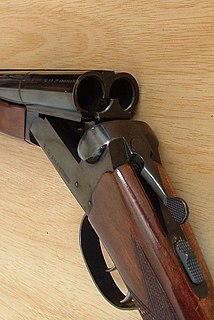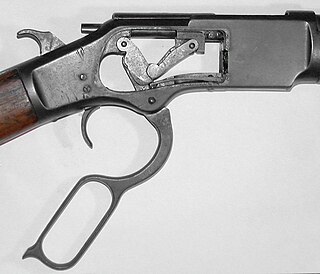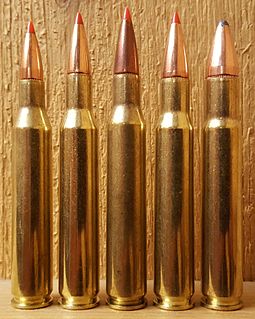A rifle is a long-barreled firearm designed for accurate shooting, with a barrel that has a helical pattern of grooves (rifling) cut into the bore wall. In keeping with their focus on accuracy, rifles are typically designed to be held with both hands and braced firmly against the shooter's shoulder via a buttstock for stability during shooting. Rifles are used extensively in warfare, self defense, law enforcement, crime, hunting, and shooting sports.

Single-shot firearms are firearms that hold only a single round of ammunition, and must be reloaded manually after every shot. The history of firearms began with single-shot designs, then multi-barreled designs appeared, and eventually many centuries passed before multi-shot repeater designs became commonplace.

A semi-automatic rifle is an autoloading rifle that fires one round each pull of the trigger. For comparison, a bolt-action rifle requires the user to cycle the bolt manually before they can fire a second time, and a fully automatic rifle fires continuously until the trigger is released. Most modern automatic rifles are selective fire, meaning the user can fire semi-automatically if desired.

In firearms terminology, an action is the functional mechanism of a breech-loading firearm that handles the ammunition cartridges, or the method by which that mechanism works. Actions are technically not present on muzzleloaders, as all those are single-shot firearms with a closed off breech with the powder and projectile manually loaded from the muzzle. Instead, the muzzleloader ignition mechanism is referred to as the lock.
A semi-automatic firearm, also called a self-loading or autoloading firearm, is a repeating firearm whose action mechanism automatically loads a following round of cartridge into the chamber (self-loading) and prepares it for subsequent firing, but requires the shooter to manually actuate the trigger in order to discharge each shot. Typically, this involves the weapon's action utilizing the excess energy released during the preceding shot to unlock and move the bolt, extracting and ejecting the spent cartridge case from the chamber, re-cocking the firing mechanism, and loading a new cartridge into the firing chamber, all without input from the user. To fire again, however, the user must actively release the trigger, allow it to "reset", before pulling the trigger again to fire off the next round. As a result, each trigger-pull only discharges a single round from a semi-automatic weapon, as opposed to a fully automatic weapon, which will shoot continuously as long as the ammunition is replete and the trigger is kept depressed.
A repeating rifle is a single-barreled rifle capable of repeated discharges between each ammunition reloads. This is typically achieved by having multiple cartridges stored in a magazine and then fed individually into the chamber by a reciprocating bolt, via either a manual or automatic action mechanism, while the act of chambering the round typically also recocks the hammer/striker for the following shot. In common usage, the term "repeating rifle" most often refers specifically to manual repeating rifles, as opposed to self-loading rifles, which use the recoil and/or blowback of the previous shot to cycle the action and load the next round, even though all self-loading firearms are technically a subcategory of repeating firearms.

Lever action is a type of action for repeating firearms that uses a manually operated cocking handle located around the trigger guard area that pivots forward to move the bolt via internal linkages, which will feed and extract cartridges into and out of the chamber, and cock the firing pin mechanism. This contrasts to other type of repeating actions such as the bolt-action, pump-action, semi-automatic, or automatic/selective-fire actions. A firearm using this operating mechanism is colloquially referred to as a levergun.
The Ruger 10/22 is a series of semi-automatic rifles produced by American firearm manufacturer Sturm, Ruger & Co., chambered for the .22 Long Rifle rimfire cartridge. It uses a patented 10-round rotary magazine, though higher capacity box magazines are also available. The standard carbine version of the Ruger 10/22 has been in production continuously since 1964, making it one of the most successful rimfire rifle designs in history, with numerous third party manufacturers making parts and accessories for upgrading and customization. The 10/22's aftermarket is so prolific that a complete 10/22 can be built without using any Ruger-made components.
The Winchester Model 70 is a bolt-action sporting rifle. It has an iconic place in American sporting culture and has been held in high regard by shooters since it was introduced in 1936, earning the moniker "The Rifleman's Rifle". The action has some design similarities to Mauser designs and it is a development of the earlier Winchester Model 54, itself based on a Mauser 98-type action.

The .270 Winchester is a rifle cartridge developed by Winchester Repeating Arms Company in 1923 and unveiled in 1925 as a chambering for their bolt-action Model 54. The cartridge is the same length as the .280 Remington, both of which are longer than the .30-06 Springfield. The .270, .280, and .30-06 were all derived from the .30-03 parent case and the bore diameter was likely inspired by 7mm Mauser. The .270 Winchester uses a .270 inch (6.86 mm) bore diameter and a .277 inch (7.04 mm) bullet diameter.
Marlin Firearms Co. is an American manufacturer of semi-automatic, lever-action and bolt-action rifles. In the past, the company made shotguns, derringers and revolvers based in Madison, North Carolina. Marlin owned the firearm manufacturer H&R Firearms. In 2007, Remington Arms, part of the Remington Outdoor Company, acquired Marlin Firearms. Remington produced Marlin-brand firearms at its Kentucky and New York manufacturing facilities. In 2020, Sturm, Ruger & Co. bought the company from bankrupt Remington Outdoor Company.

H&R 1871, LLC is a manufacturer of firearms under the Harrington & Richardson and New England Firearms trademarks. H&R is a subsidiary of JJE Capital Holdings. H&R ceased production February 27, 2015.
The Marlin Model 60, also known as the Marlin Glenfield Model 60, is a semi-automatic rifle that fires the .22 LR rimfire cartridge. Produced by Remington Arms in Huntsville, Alabama formerly in Mayfield, Kentucky, formerly by Marlin Firearms Company of North Haven, Connecticut, it has been in continuous production since 1960 and the company says it is the most popular rifle of its kind in the world. Major features include a micro-groove barrel, a cross-bolt safety, hardwood stock with Monte Carlo comb, and brass or blued steel inner magazine tube. The Marlin Model 795 is a very similar rifle and based on the Marlin Model 60, changed only to accept a detachable box magazine.

The Remington Model 14 was a pump-action repeating rifle designed for the Remington Arms company by John Pedersen. It is part of a series of rifles that include the Remington Model 14-1/2 and the Remington Model 141.
The Marlin Model 336 is a lever-action rifle and carbine made by Marlin Firearms. Since its introduction in 1948, it has been offered in a number of different calibers and barrel lengths, but is commonly chambered in .30-30 Winchester or .35 Remington, using a 20- or 24-inch barrel. Currently, the model with a 24-inch barrel is only available in .30-30 Winchester. The Model 336 is currently produced by Ruger.
The following are terms related to firearms and ammunition topics.

The Winchester Model 1907 is a blowback-operated, semi-automatic rifle produced by the Winchester Repeating Arms Company beginning in 1907 with production ending in 1957. It fired a cartridge of intermediate power, cycled through a semi-automatic operating mechanism, fed from a 5, 10, or 15 round detachable box magazine located immediately forward of the trigger guard. In size and handling, it is much like an M1 carbine, though the 1907 is heavier and fires a much harder hitting round.
The Winchester Model 1890 is a slide-action repeating rifle produced by the Winchester Repeating Arms Company in the late 19th and early 20th century.
The Winchester Model 69 is a bolt-action .22 caliber repeating rifle first produced in 1935 by the Winchester Repeating Arms Company. It was marketed as Winchester's mid-priced bolt-action rimfire sporting rifle, positioned above inexpensive single-shot rifles such as the Model 68 and beneath the prestigious Model 52. An uncommon Model 69 variant, the Model 697, was offered with a telescopic sight and no provisions for iron sights. Production ended in 1963.
The Winchester Model 67 was a single-shot, bolt-action .22 caliber rimfire rifle sold from 1934 to 1963 by Winchester Repeating Arms Company. Based on the earlier Model 60, the Model 67 was the mainstay of Winchester's inexpensive single-shot rifle lineup. A rare variant, the Model 677, was produced with telescopic sights and no provisions for iron sights.









